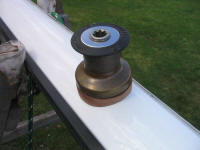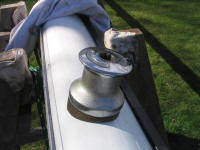|
Mast: Awlgrip (Page 3)
This page was last updated on 1 May 2005. |
|
<-Return to Page 2
and Final Success |
With the painting finally behind me, I turned my attention to reinstalling
the mast hardware that I had removed oh so many months before. This
included the masthead sheave, rigging tangs, spreader and jumper strut
bases, headstay and halyard tangs, and all the cleats and winches at the
lower end of the mast. In addition, I could now locate and install
the new fixed gooseneck, a project begun last season. |
Over the period of two sunny afternoons, I completed all the various
installations. To isolate the hardware from the painted mast, and to
hopefully stem any corrosion or paint bubbling that might occur (as is
common with painted spars), I coated the back of each piece of hardware
with a thin layer of polysulfide sealant, and also put some sealant in the
fastener holes. |
Most of the reinstallation went quickly, as I was simply reusing old holes
that I had lfet from before. In some cases, though--particularly the
winches--I had to relocate the hardware and drill and tap new holes for
fasteners, since I had decided to abandon an old aluminum, through-bolted
winch base plate that I had used previously.
I also installed some new hardware for a set
of lazy jacks that I planned to install when some newly-ordered hardware
arrived. Click here for more on the lazy
jacks. |
 To
remount the main halyard winch, I first cut out a circle of mahogany about
the same diameter as the winch base. Then, I stuck some 40-grit
discs on the spar, and rubbed the block back and forth over the sandpaper
to sand the bottom into a profile that exactly matched the spar's shape.
This took a surprisingly long time, perhaps because the particular piece
of mahogany that I used was very dense and hard. To
remount the main halyard winch, I first cut out a circle of mahogany about
the same diameter as the winch base. Then, I stuck some 40-grit
discs on the spar, and rubbed the block back and forth over the sandpaper
to sand the bottom into a profile that exactly matched the spar's shape.
This took a surprisingly long time, perhaps because the particular piece
of mahogany that I used was very dense and hard.
With that done, I drilled 1/4" holes
through the wood at each winch base fastener location, and then, with the
wooden base on the mast in the correct location, drilled and tapped the
mast for some 1/4-20 machine screws. When all the holes were tapped,
I installed the winch permanently. |
 I
repeated the process for a new winch on the other side of the mast, for
the jib halyard. For years, I had planned to install a jib halyard
winch, but never got around to it; it just wasn't that important.
With a small Barlow winch left over from the old boom (I had replaced the
reefing winch with a nicer Lewmar version), I decided to mount it on the
mast. The winch had come with a curved backing block that required
only minimal sanding to make it fit the mast, so I reused the old block,
rather than try to laboriously sand down a new one. I
repeated the process for a new winch on the other side of the mast, for
the jib halyard. For years, I had planned to install a jib halyard
winch, but never got around to it; it just wasn't that important.
With a small Barlow winch left over from the old boom (I had replaced the
reefing winch with a nicer Lewmar version), I decided to mount it on the
mast. The winch had come with a curved backing block that required
only minimal sanding to make it fit the mast, so I reused the old block,
rather than try to laboriously sand down a new one. |
Mast painting complete! Sorry, I see I
didn't take that many pictures of this process...pretty boring, I guess! |
|